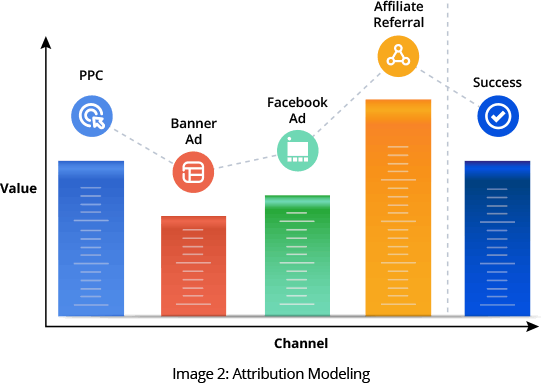Users often switch between smartphones, tablets, and desktops during their path to interact with online content. From an analytics point of view, tracking visitors across various devices is crucial. This produces many opportunities to know your customers, that provides a complete picture of the customer journey. It enables data-driven decisions, enhances user experiences, and helps you tailor your strategies to meet the evolving needs of consumers across various digital touchpoints. This is where Adobe’s Cross-Device Analytics comes into play.
Cross-Device Tracking
Cross-device tracking stitches together different user sessions that take place on different platforms. It utilizes the Experience Cloud ID service and device graph to stitch together past visits from various devices.
It can assist with a range of scenarios, such as:
- User Interaction Preferences: Determining the preferred methods for users to engage with online content and identifying which devices generate the most traffic.
- Cross-Device Purchasing Behavior: Tracking customers who add items to their cart using a PC but finalize their purchases on mobile devices.
- Page-Specific Drop-offs and Cross-Device Navigation: Identifying specific pages on mobile devices or PCs where visitors tend to abandon their session and continue their navigation on another device which may indicate potential technical issues.
Limitations of Cross-Device Analytics
Cross-Device Analytics (CDA) is a powerful and innovative tool; however, its applications are limited. Some of its limitations include:
- Exclusive to Adobe Analytics Ultimate: CDA is available only with the Adobe Analytics Ultimate package, which may not be part of your subscription.
- Workspace Dependency: CDA functionalities are confined to the Adobe Analytics Workspace environment, which can be restrictive for users accustomed to other analytics interfaces or platforms.
- Lack of Real-Time Data: Since CDA is based on a virtual report suite, it does not support real-time reporting, which can be a significant disadvantage for businesses that require immediate data insights.
- Report Time Processing Alignment: CDA operates in conjunction with Report Time Processing. As a result, not all metrics and dimensions are compatible with CDA. Key elements that are not supported include:
- Single Access: Metrics that count the times a unique value is set during a single visit.
- List Variables (List Vars): Variables that capture multiple values in a single hit.
- Counter eVars: eVars that increase each time they are set during a visit.
- Linear Allocation eVars: eVars that distribute credit evenly across all values received during conversion.
- Confined to One Report Suite: CDA cannot amalgamate data from multiple report suites. This limitation restricts data analysis within a single report suite, potentially omitting a holistic view when multiple report suites are used.
Cross-Channel Tracking
Cross-device customer tracking follows a single user across multiple devices (such as smartphones, tablets, and laptops). In contrast, cross-channel tracking monitors a user's interactions across different platforms or mediums (like email, social media, and websites).
Usage examples of cross-channel tracking include:
- Optimize the Marketing Budget: Allocate funds based on cross-channel performance to maximize return on investment. This ensures you direct your resources toward channels that yield the best results.
- Enhance User Experience: Personalize and optimize the user experience across various channels to encourage loyalty and secure repeat business.
- Data Integration and Analysis: Merge data from website analytics, email marketing, social media platforms, and online advertising to analyze customer journeys, identifying the most impactful touchpoints and campaigns.
How to Track Multi-Channel Touchpoints
Tracking customer interactions across multiple channels can be complex, especially when these touchpoints span various platforms and communication methods. Consider a scenario where a customer visits a website and shortlists their favorite products. However, they have some questions and decide to contact customer service. The service agent then provides the necessary information, assisting the customer in determining. Subsequently, the customer downloads the company's mobile app and completes a purchase through it.

The Multi-Channel Tracking Challenge
The main challenge in this scenario is that the customer's touchpoints are dispersed across different channels, not merely other devices. This raises a significant question:
Can any analytics tool sufficiently attribute and allocate a customer's journey across diverse channels?
While Cross-Device Analytics can effectively link interactions between web and app touchpoints, it falls short when integrating offline interactions, such as those with customer care. This limitation means that we may not acquire a complete 360-degree view of the customer's experience.
Understanding the Analytics Gap
By excluding the customer care touchpoint, the analytical data only partially represents the customer's journey. CDA is adept at stitching together activities on different devices but does not account for the cross-channel interactions that are integral to the customer's experience.
To truly understand your customers, you need an analytics solution that seamlessly integrates data from all touchpoints—online and offline. This holistic view is crucial for delivering personalized experiences and making informed business decisions. Without it, you risk having an incomplete understanding of your customers' pathways to purchase.
Imagine a scenario where a regular customer who typically makes purchases through your app begins browsing your website without signing in. This instance illustrates the importance of Cross-Channel Analytics (CCA), designed to handle these complex scenarios by bridging the data across multiple channels and sources.
The Role of Cross-Channel Analytics
Cross-channel analytics is crucial in analyzing and understanding user interactions and behaviors across various marketing or communication channels. This analytical approach strives to:
- Provide a holistic view of the customer's journey and interactions.
- Allow businesses to optimize their marketing strategies.
- Enhance the overall customer experience.
The Mechanism of Cross-Channel Analytics
Cross-channel analytics offers the flexibility to aggregate data from diverse sources and channels. It achieves this by:
- Utilizing a common identifier across all data sets to link different interactions.
- Integrating these data points to create a unified data set.
- Enabling a comprehensive analysis of user performance and behavior across all channels.
By leveraging cross-channel analytics, you may ensure capturing all relevant customer interactions, even when those occur across different platforms and without the continuity of a user login. This in-depth understanding is essential for tailoring marketing efforts and improving customer engagement in a multi-channel environment.
Using CCA for Attribution Modeling

Attribution modeling is a critical aspect of cross-channel analytics. It involves attributing credit to different marketing channels or devices contributing to a conversion. When datasets with a common identifier are merged, attribution can be conducted across multiple channels and devices.
Challenges with Multiple Datasets
One of the main challenges with attribution in cross-channel analytics is the potential for siloed information. Not every record within the Cross-Channel Analytics (CCA) dataset may have the necessary data to support standard out-of-the-box attribution models. This leads to the question: ‘How can these records be utilized for analysis and how can they be stitched together, if at all possible?’
Stitching Algorithm in CCA
The stitching algorithm within CCA addresses this challenge by providing a powerful feature that:
- Ensures all records share common identifiers.
- Considers both authenticated and unauthenticated sessions.
CCA offers a range of beneficial functionalities, including:
- Customizable replay frequency and lookback length.
- Various other advanced features to gain a holistic report of customer interactions.
The Relationship Between CDA and CCA
Although Cross-Device Analytics (CDA) and Cross-Channel Analytics (CCA) have similar objectives, their implementation varies due to underlying architectural differences. CDA can be viewed as a service that is part of the broader CCA framework. When used together, CCA and CDA:
- Enhance the understanding of an audience.
- Optimize marketing efforts more effectively.
These two analytical approaches work in tandem to provide a more comprehensive view of customer interactions and behaviors across various devices and channels.
By leveraging both CDA and CCA, you can effectively track and attribute customer engagements, allowing for more informed decisions and strategic marketing optimizations. The synergy between these tools is invaluable in understanding the full scope of customer behaviors in a multi-faceted digital environment.
Conclusion
Cross-Device Analytics (CDA) is a valuable tool for those who wish to monitor and analyze the patterns of users as they switch between various devices—such as desktop computers, laptops, smartphones, tablets, and other connected gadgets—in their interactions with a brand or platform. This includes understanding the frequency with which users transition from one device to another. However, it would be beneficial to integrate CDA with CCA to expand the scope of insight into more than just device-switching behavior.
CCA is designed to amalgamate and make sense of data from various sources, broadening the reach to a broader audience. Recognizing that individuals have distinct preferences for how they communicate, using multiple channels—including email, social media, and search engines—increases the chances of connecting with various segments of your target market.
If CCA does not resonate with your business model, then CDA would be preferable. Both CDA and CCA present a wealth of opportunities and areas for growth that your business can capitalize on.




